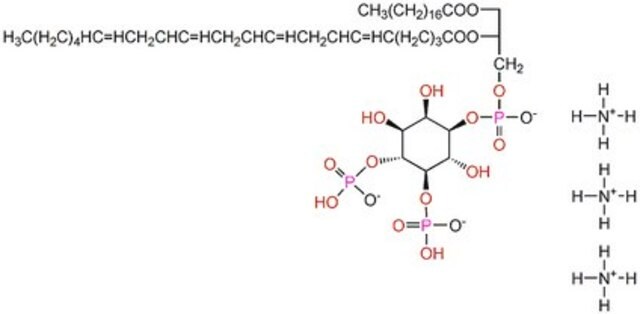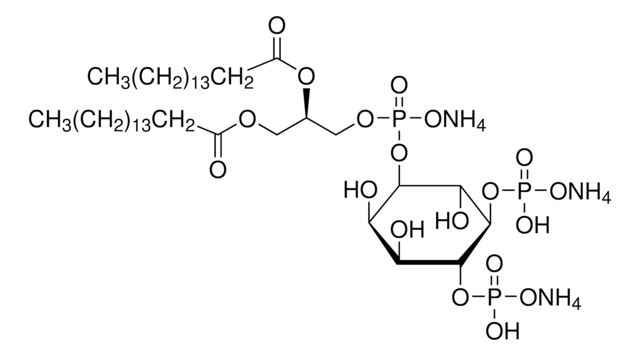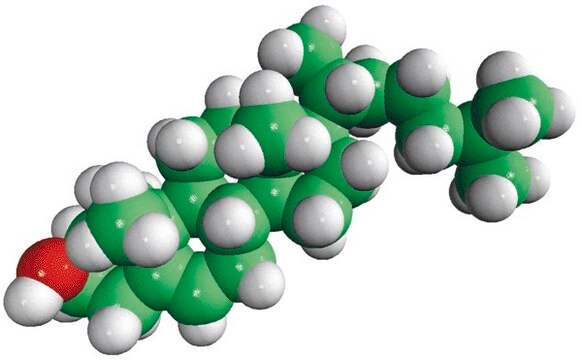Kluczowe dokumenty
850165P
Avanti
18:0-20:4 PI(4,5)P2
1-stearoyl-2-arachidonoyl-sn-glycero-3-phospho-(1′-myo-inositol-4′,5′-bisphosphate) (ammonium salt), powder
Synonim(y):
1-octadecanoyl-2-(5Z,8Z,11Z,14Z-eicosatetraenoyl)-sn-glycero-3-[phosphoinositol-4,5-bisphosphate] (ammonium salt); PIP2[4′,5′](18:0/20:4(5Z,8Z,11Z,14Z))
About This Item
Polecane produkty
Próba
>99% (TLC)
Formularz
powder
opakowanie
pkg of 1 × 100 μg (with stopper and crimp cap (850165P-100ug))
pkg of 1 × 500 μg (with stopper and crimp cap (850165P-500ug))
producent / nazwa handlowa
Avanti Research™ - A Croda Brand 850165P
typ lipidu
cardiolipins
phospholipids
Warunki transportu
dry ice
temp. przechowywania
−20°C
ciąg SMILES
[H][C@@](COP([O-])(O[C@H]1[C@H](O)[C@@H](OP(O)([O-])=O)[C@H](OP([O-])(O)=O)[C@@H](O)[C@H]1O)=O)(OC(CCC/C=C\C/C=C\C/C=C\C/C=C\CCCCC)=O)COC(CCCCCCCCCCCCCCCCC)=O.[NH4+].[NH4+].[NH4+]
Klucz InChI
GAIOWTITBYPFJE-WGJQOQIESA-N
Opis ogólny
Zastosowanie
- in cryo-electron microscopy (cryo-EM) grid preparation
- in host 1-O-1-(Z)-octadecenyl-2-arachidonoyl-sn-glycero-3-phosphocholine (plasmenyl-SAPC) small unilamellar vesicles (SUVs) in the presence of H2O2 to activate cyt c plasmalogenase activity
- to study whether acyl chain types affect phosphatidylinositol 4,5-bisphosphate (PIP2) cluster formation
Opakowanie
Informacje prawne
Kod klasy składowania
11 - Combustible Solids
Wybierz jedną z najnowszych wersji:
Certyfikaty analizy (CoA)
It looks like we've run into a problem, but you can still download Certificates of Analysis from our Dokumenty section.
Proszę o kontakt, jeśli potrzebna jest pomoc Obsługa Klienta
Masz już ten produkt?
Dokumenty związane z niedawno zakupionymi produktami zostały zamieszczone w Bibliotece dokumentów.
Klienci oglądali również te produkty
Global Trade Item Number
| SKU | GTIN |
|---|---|
| 850165P-100UG | 4061835227167 |
| 850165P-1MG | 4065270903457 |
| 850165P-500UG | 4061835227174 |
| 850165P-5MG | 4065270903464 |
Nasz zespół naukowców ma doświadczenie we wszystkich obszarach badań, w tym w naukach przyrodniczych, materiałoznawstwie, syntezie chemicznej, chromatografii, analityce i wielu innych dziedzinach.
Skontaktuj się z zespołem ds. pomocy technicznej













